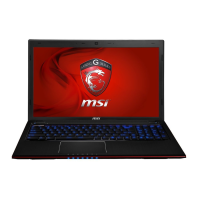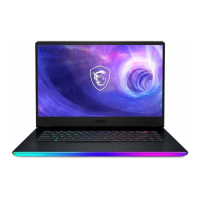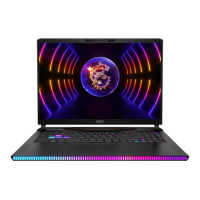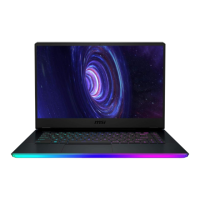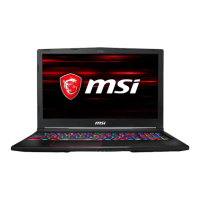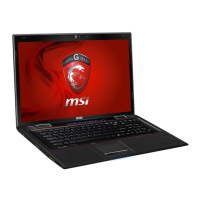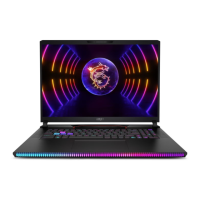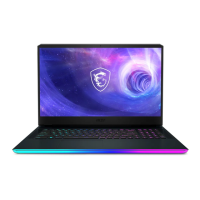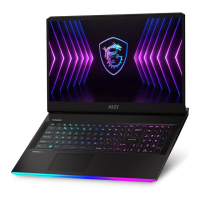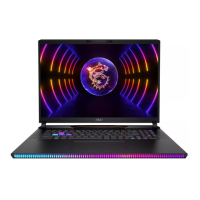Do you have a question about the MSI GE620 and is the answer not in the manual?
Provides an overview of the manual and essential introductory information for new users.
Details compliance statements, including FCC and CE conformity requirements.
Outlines crucial safety precautions and guidelines for operating the equipment.
Explains the safe handling, replacement, and disposal of lithium-ion batteries.
Guides users through the manual's structure, chapter contents, and navigation.
Details the process of unpacking the notebook and its included accessories.
Lists detailed technical specifications for the notebook's hardware components.
Describes the notebook's physical appearance, key external features, and views.
Covers connecting AC/DC power, battery usage, and power saving functions.
Explains the different key types, including typewriter, numeric, and function keys.
Guides on connecting various external peripherals, displays, and communication devices.
Provides information on upgrading or replacing internal components like memory and storage.
Explains the purpose, scenarios, and method for accessing the BIOS setup utility.
Lists the keyboard keys used for navigating and interacting within the BIOS utility.
Provides an overview of the main BIOS setup menus and their general functions.
Details system overview, date, time, and SATA information settings in the BIOS.
| Bus type | DMI |
|---|---|
| Stepping | D2 |
| Tjunction | 100 °C |
| Processor cache | 6 MB |
| Processor cores | 4 |
| Processor model | i7-2630QM |
| System bus rate | 5 GT/s |
| Processor family | Intel® Core™ i7 |
| Processor series | Intel Core i7-2600 Mobile Series |
| Processor socket | Socket 988 |
| Processor threads | 8 |
| Processor codename | Sandy Bridge |
| Processor frequency | 2 GHz |
| Processor cache type | Smart Cache |
| Processor lithography | 32 nm |
| Processor manufacturer | Intel |
| Processor front side bus | - MHz |
| PCI Express slots version | 2.0 |
| Processor boost frequency | 2.9 GHz |
| Processor operating modes | 64-bit |
| ECC supported by processor | No |
| PCI Express configurations | 1x16, 2x8, 1x8+2x4 |
| Thermal Design Power (TDP) | 45 W |
| CPU multiplier (bus/core ratio) | 20 |
| Maximum number of PCI Express lanes | 16 |
| Motherboard chipset | Intel® HM65 Express |
| Storage media | HDD |
| Optical drive type | - |
| Card reader integrated | Yes |
| Total storage capacity | 640 GB |
| Compatible memory cards | Memory Stick (MS), MMC, MS PRO, SD, SDHC, SDXC, xD |
| Display diagonal | 15.6 \ |
| Display resolution | 1366 x 768 pixels |
| Native aspect ratio | 16:9 |
| Internal memory | 4 GB |
| Internal memory type | DDR3-SDRAM |
| Maximum internal memory | - GB |
| Type | PC |
| Power supply type | AC/DC |
| Wireless technology | Wi-Fi |
| Graphics card family | NVIDIA |
| Ethernet interface type | Gigabit Ethernet |
| Compatible operating systems | Windows 7 |
| Compliance industry standards | IEEE 802.3, IEEE 802.3u, IEEE 802.3ab |
| On-board graphics card ID | 0x116 |
| Discrete graphics card model | NVIDIA® GeForce® GT 540M |
| On-board graphics card model | Intel® HD Graphics 3000 |
| Discrete graphics memory type | GDDR3 |
| On-board graphics card family | Intel® HD Graphics |
| On-board graphics card base frequency | 650 MHz |
| On-board graphics card dynamic frequency (max) | 1100 MHz |
| Audio system | THX TruStudio Pro |
| Pointing device | Touchpad |
| Keyboard number of keys | 103 |
| Video capturing speed | 30 fps |
| Wi-Fi standards | 802.11b, 802.11g, Wi-Fi 4 (802.11n) |
| Bluetooth version | 2.1+EDR |
| Cabling technology | 10/100/1000Base-T(X) |
| Ethernet LAN data rates | 10, 100, 1000 Mbit/s |
| Operating system installed | Windows 7 Home Premium |
| HDMI version | 1.4 |
| Charging port type | DC-in jack |
| USB 2.0 ports quantity | USB 2.0 ports have a data transmission speed of 480 Mbps, and are backwards compatible with USB 1.1 ports. You can connect all kinds of peripheral devices to them. |
| Firewire (IEEE 1394) ports | 0 |
| USB 3.2 Gen 1 (3.1 Gen 1) Type-A ports quantity | 2 |
| AC adapter power | 120 W |
| Battery life (max) | - h |
| Number of battery cells | 6 |
| Form factor | Clamshell |
| Product color | Black |
| Processor code | SR02Y |
| Processor ARK ID | 52219 |
| Processor package size | 37.5 x 37.5 (rPGA998) mm |
| Supported instruction sets | AVX |
| Intel Identity Protection Technology version | 1.00 |
| Cables included | AC |
| Depth | 249.5 mm |
|---|---|
| Width | 383 mm |
| Weight | 2400 g |
| Height (rear) | 37.6 mm |
| Height (front) | 32.3 mm |
